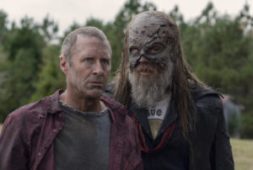
Main Point of Discussion: Jesus is willing to forgive us of our sin.
The Movie Clip: “Every traitor belongs to me. His blood is my property.”
The Chronicles of Narnia: The Lion, the Witch, and the Wardrobe is a fictional story based on the true message of the Bible: there is a God who loves us so much that He is willing to give His life for ours! This is a fantastic movie about a lion king named Aslan who pays the ultimate price for people’s disobedience in order to protect and save their lives.
Introducing the Clip:
The Chronicles of Narnia is a fantastic film because it tells a great story, a story about a king who loves his people so much he gives his life for theirs. Just prior to the scene we are about to watch, Edmund had sided with an evil Witch and betrayed his family and friends. But, he eventually sees through her lies and has a change of heart. Edmund then gets rescued by King Aslan’s forces, but unfortunately for Edmund, the law of the land demands that a traitor’s life belongs to the evil Witch. Let’s take a look at this clip to see how King Aslan handles the situation.
Scene Script:
BEGIN CLIP AT 1 hour 31 minutes and 48 seconds (in chapter 16).
- Henchman: Jadis, The Queen of Narnia. Empress of the Lone Islands. (The crowds murmur against her presence.)
The Witch: You have a traitor in your midst, Aslan.
Aslan: His offense was not against you.
The Witch: Have you forgotten the law upon which Narnia was built?
Aslan: (Roars) Do not cite the Deep Magic to me, Witch. I was there when it was written.
The Witch: Then you’ll remember well that every traitor belongs to me. His blood is my property. (At this, Edmund’s older brother Peter unsheathes his sword and steps toward the Witch.)
Peter: Try and take him then.
The Witch: Do you really think that mere force will deny me my right, little king? Aslan knows that unless I have blood, as the law demands, all of Narnia will be overturned and perish in fire and water. That boy will die on the Stone Table as is tradition. You dare not refuse me.
Aslan: Enough! I shall talk with you alone. (He and the Witch step into his tent to converse while the others wait outside. When they finally step back out, the Witch has a look of satisfaction upon her face, while Aslan seems upset. The Witch walks past Edmund without saying a word and gets back on her chariot.)
Aslan: She has renounced her claim on the Son of Adam’s blood. (The crowd cheers, but Aslan does not look happy over the news.)
The Witch: How do I know your promise will be kept? (Aslan roars and the Witch shrinks away in fear.)
(While the crowd continues to celebrate, Lucy looks at Aslan and smiles, but realizes he does not smile back. Instead, he appears to be deep in thought, sadden by what has just happened. Lucy’s own smile quickly disappears.)
Transitional Statement:
In this clip, we saw the king of the land grant forgiveness to the young man Edmund, who had clearly sinned by betraying his family and friends. The evil Witch wanted the young boy to be killed, in accordance with the Law, but King Aslan pardoned him. But this wasn’t the only time a King pardoned a person who was undeniably guilty of sin.
Divide into Small Groups:
Let’s go ahead and split up into our discussion groups, and then afterward we’ll come back together for a final word.
CLICK HERE for a quick training article on how to maximize your small groups using our small group format—a great resource to equip your small group leaders.
Discussion Questions:
- AROUND THE CIRCLE: As we begin, let’s all take a second to share our name and whether or not the witch in this clip would make us nervous or afraid.
- ASK SOMEONE: According to the clip, what basis does the witch have in coming to the camp for Edmund? (She quotes the Law of Narnia.)
- ASK SOMEONE: How does Aslan respond to her “quoting the law” to him?
- ASK A FEW: Do you think “the law” that the witch was referring to was fair? Why or why not?
- ASK A FEW: How do you think Edmund felt, standing there in front of a large crowd, with his “dirty laundry being aired” in front of everyone?
- ASK A FEW: Do you think that Edmund deserved death like the witch said? Why or why not?
- ASK SOMEONE: What were some of the parallels between the movie clip and this story? (Leaders – Edmund and the woman were both guilty, Edmund and the woman both had an accuser who publicly proclaimed their sins in front of a crowd, the accusers made their argument to the highest authority present…Aslan and Jesus, and Edmund was pardoned by Aslan as the woman was pardoned by Jesus.)
- ASK SOMEONE: According to the Law of Moses, what should be done to the woman? (Leaders – you may need to explain that stoning was an ancient form of capital punishment.)
- ASK A FEW: Does that seem fair to you? Why or why not?
- ASK A FEW: How do you think the woman felt, standing in front of everyone with her sin being made public?
- ASK SOMEONE: How does Jesus INITIALLY respond to the woman’s accusers? (Leaders – He says nothing, and just writes on the ground.)
- ASK A FEW: When Jesus finally speaks to the accusers, He tells them, “If any one of you is without sin, let him be the first to throw a stone at her.” What does He mean by this?
- ASK A FEW: At the end of the story, the woman’s accusers have all left and it’s just Jesus and the woman left talking. Does Jesus condemn her or not? How do you know?
- AROUND THE CIRCLE: Do you think Jesus did the right thing? Why or why not?
- AROUND THE CIRCLE: I can guarantee you that in this coming week, each of us will face the temptation to sin. What part of our discussion tonight will help you choose to be obedient to God, and not sin?
Read the following passage:
- John 8:1-11 (NIV)
1But Jesus went to the Mount of Olives. 2At dawn he appeared again in the temple courts, where all the people gathered around him, and he sat down to teach them. 3The teachers of the law and the Pharisees brought in a woman caught in adultery. They made her stand before the group 4and said to Jesus, “Teacher, this woman was caught in the act of adultery. 5In the Law Moses commanded us to stone such women. Now what do you say?” 6They were using this question as a trap, in order to have a basis for accusing him.
But Jesus bent down and started to write on the ground with his finger. 7When they kept on questioning him, he straightened up and said to them, “If any one of you is without sin, let him be the first to throw a stone at her.” 8Again he stooped down and wrote on the ground.
9At this, those who heard began to go away one at a time, the older ones first, until only Jesus was left, with the woman still standing there. 10Jesus straightened up and asked her, “Woman, where are they? Has no one condemned you?”
11″No one, sir,” she said.
“Then neither do I condemn you,” Jesus declared. “Go now and leave your life of sin.”
Wrap Up:
Tonight we watched a scene from a very famous movie, The Chronicles of Narnia. In it, Edmund had to face the consequences of his sin. There was no doubt that Edmund was guilty and the witch knew it. In fact, she was so confident that Edmund was guilty, she was willing to face Aslan and his forces at his camp to prove it. But, instead of seeing the witch get to kill Edmund as she intended, we see Aslan speak with her privately. After Aslan speaks with the witch, the witch turns and leaves, because Aslan has forgiven Edmund.
Then we read a story from the Bible that told an almost identical story. A woman had been caught in the act of adultery, so there was no doubt she was guilty. Her accusers were so sure of it that they brought her to Jesus to prove it. Unfortunately for them, but fortunate for her, Jesus forgave her of her sin, and did not condemn her to the death she deserved. Then Jesus told her to stop sinning.
While the story from The Chronicles of Narnia is only a fictional account of forgiveness, the story from the Bible is a completely true one. This story is in the Bible for a couple of reasons. First, it’s true. Jesus really did forgive this woman even though she was completely guilty of her sin. Secondly, it shows us how Jesus is willing to forgive us of our sins. No matter what we’ve done, or how humiliating or shameful it is, Jesus will forgive us.
Jesus could forgive the woman because, like Aslan in the movie, He was willing to lay down His life for those He loved. I didn’t show you the end of the movie, but at its close, we see Aslan give his life in exchange for Edmund’s. At the end of Jesus’ ministry on earth, He gave His life on a cross in exchange for ours. That’s why Jesus could forgive the woman and did. And that’s why Jesus can and will forgive each of us.
As we close in prayer tonight, if any of you want to talk about this more, just grab one of our adult leaders or me. We would be VERY HAPPY to discuss this with you further.
Close in Prayer.
Jonathan McKee
Jonathan McKee is the author of over twenty books including the brand new The Guy's Guide to FOUR BATTLES Every Young Man Must Face; The Teen’s Guide to Social Media & Mobile Devices; If I Had a Parenting Do Over; and the Amazon Best Seller - The Guy's Guide to God, Girls and the Phone in Your Pocket. He speaks to parents and leaders worldwide, all while providing free resources for youth workers on TheSource4YM.com. Jonathan, his wife Lori, and their three kids live in California.




sarah
May 16, 2011 at 12:00 ami love this clip and illustration. thanks for creating this website.
Lewis
May 1, 2013 at 12:00 amAbsolutely fantastic! Definitely using this with my youth group! Thank you 😀
Edwardhip
April 23, 2025 at 12:53 pmolympe casino avis: casino olympe – olympe casino en ligne
PeterDor
April 25, 2025 at 4:01 amTadalafil achat en ligne Cialis sans ordonnance 24h Tadalafil sans ordonnance en ligne tadalmed.com
RobertBus
April 25, 2025 at 5:04 amhttps://tadalmed.shop/# Cialis generique prix
Bradleytib
April 25, 2025 at 7:44 ampharmacie en ligne livraison europe: pharmacie en ligne – pharmacie en ligne france pas cher pharmafst.com
PeterDor
April 26, 2025 at 5:57 amachat kamagra Kamagra pharmacie en ligne kamagra oral jelly
Bradleytib
April 26, 2025 at 7:34 amachat kamagra: kamagra gel – acheter kamagra site fiable
Bernardnes
April 26, 2025 at 7:58 amAchat mГ©dicament en ligne fiable: pharmacie en ligne sans ordonnance – pharmacie en ligne france livraison belgique pharmafst.com
BillieBob
April 26, 2025 at 8:27 pmvente de mГ©dicament en ligne: Pharmacies en ligne certifiees – pharmacie en ligne livraison europe pharmafst.com
RobertBus
April 27, 2025 at 2:55 amhttps://tadalmed.com/# Cialis sans ordonnance 24h
PeterDor
April 28, 2025 at 7:59 amCialis sans ordonnance pas cher Acheter Cialis Cialis sans ordonnance 24h tadalmed.com
RobertBus
April 28, 2025 at 8:07 amhttps://kamagraprix.shop/# kamagra oral jelly
Walterlip
April 28, 2025 at 10:44 amhttp://medicinefromindia.com/# medicine courier from India to USA
Stevenzen
April 28, 2025 at 11:07 ammexico pharmacies prescription drugs: Rx Express Mexico – Rx Express Mexico
Dannycep
April 28, 2025 at 11:16 amcanadian pharmacy king reviews: ExpressRxCanada – canada pharmacy online
Dannycep
April 29, 2025 at 5:56 ammexican online pharmacy: mexican rx online – RxExpressMexico
Michaelkah
April 29, 2025 at 6:09 amcanadian pharmacy 365 Express Rx Canada pharmacies in canada that ship to the us
Michaelkah
April 29, 2025 at 7:15 pmindian pharmacy online shopping medicine courier from India to USA Medicine From India
Elmerwab
May 1, 2025 at 8:08 pmvavada casino: вавада казино – вавада официальный сайт
ZackaryPoimb
May 1, 2025 at 8:53 pmhttp://vavadavhod.tech/# вавада
ZackaryPoimb
May 5, 2025 at 8:43 pmhttp://pinuprus.pro/# пин ап зеркало
Richardamulp
May 7, 2025 at 2:25 pmpin up casino pin-up pin up
Elmerwab
May 7, 2025 at 3:34 pmpin up: pin-up casino giris – pin up az
Lorenzonor
May 9, 2025 at 4:06 amreliable online pharmacy Cialis Cialis without prescription generic tadalafil
Ronaldneose
May 9, 2025 at 4:45 amhttps://zipgenericmd.shop/# Cialis without prescription
Jeremynek
May 9, 2025 at 7:23 ambest price for Viagra: buy generic Viagra online – secure checkout Viagra
Robertdrono
May 9, 2025 at 7:58 amverified Modafinil vendors: modafinil legality – doctor-reviewed advice
Ronaldneose
May 9, 2025 at 10:39 amhttp://modafinilmd.store/# modafinil legality
Lorenzonor
May 9, 2025 at 10:45 amgeneric sildenafil 100mg fast Viagra delivery trusted Viagra suppliers
Albertoren
May 9, 2025 at 11:22 amdoctor-reviewed advice: modafinil pharmacy – buy modafinil online
Jeremynek
May 9, 2025 at 12:55 pmno doctor visit required: same-day Viagra shipping – buy generic Viagra online
Robertdrono
May 9, 2025 at 3:09 pmcheap Cialis online: affordable ED medication – order Cialis online no prescription
Albertoren
May 9, 2025 at 4:02 pmonline Cialis pharmacy: secure checkout ED drugs – Cialis without prescription
Ronaldneose
May 9, 2025 at 4:28 pmhttp://modafinilmd.store/# verified Modafinil vendors
Lorenzonor
May 9, 2025 at 5:04 pmdoctor-reviewed advice Modafinil for sale modafinil 2025
Jeremynek
May 9, 2025 at 6:21 pmpurchase Modafinil without prescription: purchase Modafinil without prescription – modafinil pharmacy
Robertdrono
May 9, 2025 at 8:03 pmbuy generic Cialis online: best price Cialis tablets – Cialis without prescription
Albertoren
May 9, 2025 at 8:39 pmverified Modafinil vendors: modafinil legality – Modafinil for sale
Ronaldneose
May 9, 2025 at 10:11 pmhttps://maxviagramd.shop/# fast Viagra delivery
Lorenzonor
May 9, 2025 at 11:04 pmdiscreet shipping no doctor visit required best price for Viagra
Ronaldneose
May 10, 2025 at 12:35 amhttp://zipgenericmd.com/# cheap Cialis online
Robertdrono
May 10, 2025 at 12:47 amFDA approved generic Cialis: secure checkout ED drugs – secure checkout ED drugs
Albertoren
May 10, 2025 at 1:27 amViagra without prescription: secure checkout Viagra – generic sildenafil 100mg
Jeremynek
May 10, 2025 at 3:41 amcheap Viagra online: no doctor visit required – generic sildenafil 100mg
Lorenzonor
May 10, 2025 at 5:20 amgeneric tadalafil affordable ED medication cheap Cialis online
Robertdrono
May 10, 2025 at 5:58 ambuy generic Cialis online: discreet shipping ED pills – secure checkout ED drugs
Albertoren
May 10, 2025 at 6:26 amsafe modafinil purchase: purchase Modafinil without prescription – modafinil pharmacy
Jeremynek
May 10, 2025 at 9:27 amViagra without prescription: Viagra without prescription – fast Viagra delivery
Robertdrono
May 10, 2025 at 11:12 ammodafinil pharmacy: modafinil 2025 – modafinil legality
Ronaldneose
May 10, 2025 at 11:28 amhttps://modafinilmd.store/# modafinil pharmacy
Albertoren
May 10, 2025 at 11:30 ampurchase Modafinil without prescription: modafinil 2025 – legal Modafinil purchase
Jeremynek
May 10, 2025 at 3:24 pmtrusted Viagra suppliers: trusted Viagra suppliers – generic sildenafil 100mg
Robertdrono
May 10, 2025 at 4:37 pmpurchase Modafinil without prescription: modafinil legality – safe modafinil purchase
Ronaldneose
May 10, 2025 at 5:23 pmhttp://zipgenericmd.com/# best price Cialis tablets
Jeremynek
May 10, 2025 at 8:59 pmsame-day Viagra shipping: no doctor visit required – generic sildenafil 100mg
Robertdrono
May 10, 2025 at 9:40 pmbest price for Viagra: discreet shipping – order Viagra discreetly
Ronaldneose
May 10, 2025 at 10:54 pmhttps://modafinilmd.store/# doctor-reviewed advice
Lorenzonor
May 10, 2025 at 11:11 pmreliable online pharmacy Cialis secure checkout ED drugs reliable online pharmacy Cialis